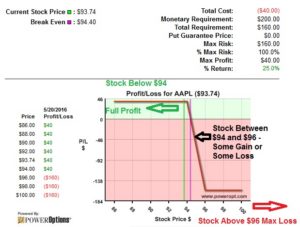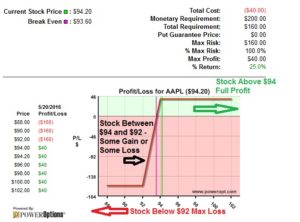After one of our recent PowerOptions webinars an attendee asked:
“What happens if you have a vertical call or put credit spread that expires In the money?”
If both options of a credit spread (Bear Call Credit or Bull Put Credit) are in the money at expiration you will receive the full loss on the spread. You will be obligated to deliver shares of stock or buy stock at the short option strike price, and your broker would use the long option to cover the obligation.
The most important thing to remember in any spread position is that you have sold a call option or sold a put option. This means you still may have to fulfill the obligation of the sold option contract.
Selling a call obligates you to deliver shares of stock at the strike price, if the call is in the money (stock is above the call strike price)
Selling a put obligates you to buy shares of stock at the strike price, if the put is in the money (stock is below the put strike price)
In a Bear Call spread I will sell an OTM call, and buy a higher strike call with the same expiration. This will result in a net credit. Even though the margin for the trade is limited to the difference in strike prices minus the net credit, I still may have an obligation to deliver stock I do not own at the short call strike price.
Let’s say I had entered a Bear Call Credit spread on AAPL such as:
Sell to Open 20-MAY 94 call at -$0.45
Buy to Open 20-May 96 call at $0.05
Net credit = -$0.40
Max Risk = $1.60 (2 point strike difference – $0.40 credit)

Selling the May 94 call obligates you to deliver shares of AAPL, if the stock is trading above $94 at expiration. There are 3 outcomes to this trade:
- AAPL closes on 20-MAY below $94 – Both calls expire worthless and you keep the full net credit. The trade is successful.
- AAPL closes on 20-MAY above $96 – Both calls are now In the Money. You would be forced to deliver shares of stock at $94.00, but you have the right to buy them at $96.00. Your broker would exercise the 96 call, buying shares of stock at that price to fulfill the obligation to deliver shares of stock at $94.00. This would result in a -$2.00 loss per contract, but you keep the $0.40 initial net credit. You would have the full loss of -$1.60 on the spread.
- AAPL closes on 20-MAY at $95.00, or anywhere between $94 and $96 – Your $96.00 call is out of the money and would expire worthless. You have an obligation to deliver shares of stock at $94.00. You would be assigned on the In the Money 94 call. Since you do not own the stock in your account, this would result in you now being short 100 shares (or whatever # of contracts you sold * 100) of AAPL at $94.00. In this case you would likely Buy to Close the short call instead of allowing it to remain ITM at expiration. If AAPL was trading at $95.00 or so on Friday afternoon, May 20th, I would likely put in an order to Buy to Close the 20-MAY $94 call at $1.10 or $1.05 or so. This would cancel the obligation to deliver shares of AAPL at the $94 strike. I would keep the $0.40 net credit, so my loss would be -$0.70 or so. This is less than the full loss of -$1.60, but still a loss.
Let’s take a look at the Bull Put Side.
Sell to Open 20-MAY 94 put at -$0.45
Buy to Open 20-MAY 92 put at $0.05
Net credit = -$0.40
Max Risk = $1.60 (2 point strike difference – $0.40 credit)

Selling the May 94 put obligates you to buy shares of AAPL if the stock is trading below $94.00 at expiration. There are 3 outcomes to this trade, as well:
- AAPL closes on 20-MAY above $94.00 – Both puts expire worthless and you keep the full net credit. The trade is successful.
- AAPL closes on 20-MAY below $92.00 – Both puts are now In the Money. You would be forced to buy shares of AAPL at $94.00 / share, but you have the right to sell those shares of stock at $92.00. If left open through expiration with no adjustment, your broker would purchase shares of stock for you at $94.00 and then immediately sell those shares at $92.00. You would have a -$2.00 loss, but you keep the $0.40 net credit. This would result in the full loss of $1.60 per contract.
- AAPL closes on 20-MAY at $93.00, or anywhere between $94 and $92 – Your $92.00 put is out of the money and would expire worthless. You have an obligation to buy shares of stock at $94.00. You would be assigned on the In the Money 94 put. On Monday, you would be long 100 shares of AAPL in your account with a cost basis of $93.60 (Put stock at $94.00 – $0.40 initial net credit). In this case you would likely Buy to Close the short put instead of allowing it to remain ITM at expiration. If AAPL was trading at $93.00 or so on Friday Afternoon, May 20th, I would likely put in an order to Buy to Close the 20-MAY $94 put at $1.10 or $1.05 or so. This would cancel the obligation to buy shares of AAPL at the $94 strike. I would keep the $0.40 net credit, so my loss would be -$0.70 or so. This is less than the full loss of -$1.60, but still a loss.
I hope this helps you clarify the potential outcomes of a credit spread at expiration. Remember, even though you entered a ‘spread’ you still have the same obligations for delivering or buying stock at the short option strike, just as though you had sold those options as a Naked Call or a Naked Put. But, you still have the same rights for purchasing the long options if you had bought the call or bought the put outright.
meziggy
this provides great information. Thank you!!!
Kel
Very good info and very well explained. Thank you!
Vijay
Can’t get any clearer than this! Thank you.
Angel Cruz
Best explanation I have found so far. Good work!
Antonio
I understand that I’d lose the difference in strike, say a loss of $100 for a single 1-strike spread.
Are you saying we can avoid paying commissions, not close the spread before expiration, and that the broker will take care of doing the math?
Russ
This article has been bookmarked for life! Thank you, thank you, thank you.
Rich
What if a bear call spread closes ITM on the short and OTM on the long. Do you get assigned with a theoretical unlimited loss since the long is worthless?
Darren Stone
I think you would be long 100 AAPL Monday morning at the strike price. So you would lose or gain whatever AAPL did aftermarket Friday and premarket Monday morning. So same as being long in the stock over the weekend. Plus a margin call if your balance does not cover. x All stocks have a limited potential loss if they go to $0.
Thomas
Very, very helpful
Syed
I recently discovered the Put/Call credit spread, i decided to trade just one spread to understand the concept i would really appreciate it if u can explain this:
SPY put buy @ $301 for .08
SPY put sell @ $301.5 for .10
profit $2 credit
SPY @ expiration is @ 311.46
it expired today and before it expired it was showing both puts @ 0.01 i’m guessing both of the puts expired worthless correct?
but i see a -$2 loss on my robin hood account i’m confused as hell and i haven’t got back my collateral either.
Harry
Thanks for the blog post – Being a newbie, this provided understanding and peace of mind
Chox
Well written and clarified what I was looking for. Thanks very much!